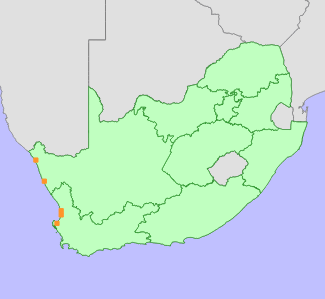|
Scientific Name | Lycium strandveldense A.M.Venter |
Higher Classification | Dicotyledons |
Family | SOLANACEAE |
National Status |
Status and Criteria | Least Concern |
Assessment Date | 2014/06/06 |
Assessor(s) | L. von Staden |
Justification | A common and relatively widespread species (EOO 8277 km²), which although threatened in placed by habitat loss, is not yet considered in danger of extinction. |
Distribution |
Endemism | South African endemic |
Provincial distribution | Northern Cape, Western Cape |
Range | West Coast of South Africa between Port Nolloth and Velddrif. |
Habitat and Ecology |
Major system | Terrestrial |
Major habitats | Fynbos, Succulent Karoo |
Description | Sandy flats and dunes on low-lying areas near the coast. |
Threats |
| Some subpopulations are threatened by habitat loss to coastal development and dune mining. |
Population |
This species is common in suitable habitat (Venter and Venter 2003). It is currently known from only a few disjunct records, collected mainly near towns and roads. It is likely to be more common than records indicate as much of its range still remains to be surveyed. Although this species may be declining in places due to habitat loss, more than 80% of its coastal habitat remains undisturbed, and it is unlikely to be facing extinction in the near future.
|
Population trend | Stable |
Notes |
| This species is possibly of hybrid origin (L. afrum x L. tetrandrum) (Manning and Goldblatt 2012). |
Assessment History |
Taxon assessed |
Status and Criteria |
Citation/Red List version | | Lycium strandveldense A.M.Venter | Least Concern | 2015.1 | |
Bibliography |
Manning, J.C. and Goldblatt, P. 2012. Plants of the Greater Cape Floristic Region 1: The Core Cape Flora. Strelitzia 29. South African National Biodiversity Institute, Pretoria.
Venter, A.M. and Venter, H.J.T. 2003. Lycium strandveldense (Solanaceae), a new species from the western coast of South Africa. South African Journal of Botany 69(4):476-479.
|
Citation |
| von Staden, L. 2014. Lycium strandveldense A.M.Venter. National Assessment: Red List of South African Plants version 2024.1. Accessed on 2025/10/18 |
 Comment on this assessment
Comment on this assessment


